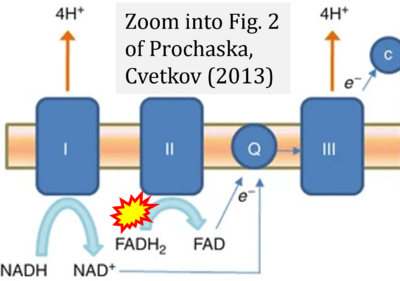Prochaska 2013 Springer: Difference between revisions
From Bioblast
No edit summary |
No edit summary |
||
| (One intermediate revision by the same user not shown) | |||
| Line 1: | Line 1: | ||
{{Publication | {{Publication | ||
|title=Prochaska LJ, Cvetkov TL (2013) Mitochondrial electron transport. | |title=Prochaska LJ, Cvetkov TL (2013) Mitochondrial electron transport. In: Roberts, G.C.K. (eds) Encyclopedia of Biophysics. Springer, Berlin, Heidelberg. https://doi.org/10.1007/978-3-642-16712-6_25 | ||
|info=[https://link.springer.com/referenceworkentry/10.1007/978-3-642-16712-6_25 Open Access] | |info=[https://link.springer.com/referenceworkentry/10.1007/978-3-642-16712-6_25 Open Access] | ||
|authors=Prochaska LJ, Cvetkov TL | |authors=Prochaska LJ, Cvetkov TL | ||
|year=2013 | |year=2013 | ||
|journal=Springer | |journal=Springer | ||
|abstract=The redox components localized in the mitochondrial inner membrane which couple the oxidation of metabolic substrates such as reduced nicotinamide adenine dinucleotide (NADH) and reduced flavins (e.g., FADH2) to the reduction of molecular oxygen to water, while conserving the released redox-linked energy into vectorial translocation of protons to establish a transmembrane protonmotive force for subsequent ATP synthesis. | |abstract=The redox components localized in the mitochondrial inner membrane which couple the oxidation of metabolic substrates such as reduced nicotinamide adenine dinucleotide (NADH) and reduced flavins (e.g., FADH2) to the reduction of molecular oxygen to water, while conserving the released redox-linked energy into vectorial translocation of protons to establish a transmembrane protonmotive force for subsequent ATP synthesis. | ||
}} | }} | ||
Latest revision as of 17:27, 19 March 2023
| Prochaska LJ, Cvetkov TL (2013) Mitochondrial electron transport. In: Roberts, G.C.K. (eds) Encyclopedia of Biophysics. Springer, Berlin, Heidelberg. https://doi.org/10.1007/978-3-642-16712-6_25 |
Prochaska LJ, Cvetkov TL (2013) Springer
Abstract: The redox components localized in the mitochondrial inner membrane which couple the oxidation of metabolic substrates such as reduced nicotinamide adenine dinucleotide (NADH) and reduced flavins (e.g., FADH2) to the reduction of molecular oxygen to water, while conserving the released redox-linked energy into vectorial translocation of protons to establish a transmembrane protonmotive force for subsequent ATP synthesis.
Correction: FADH2 and Complex II
- FADH2 is shown as the substrate feeding electrons into Complex II (CII). This is wrong and requires correction - for details see Gnaiger (2024).
- Gnaiger E (2024) Complex II ambiguities ― FADH2 in the electron transfer system. J Biol Chem 300:105470. https://doi.org/10.1016/j.jbc.2023.105470 - »Bioblast link«
Labels:
Pathway: S


